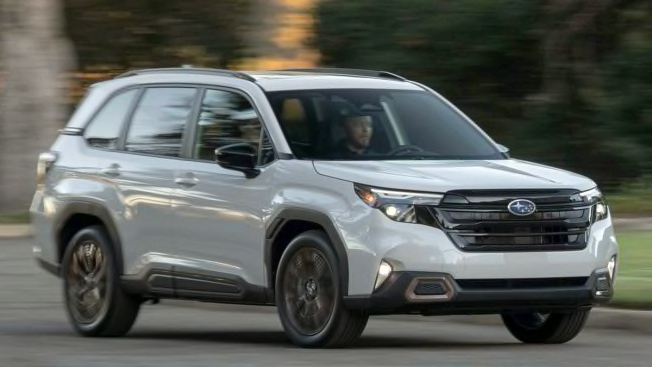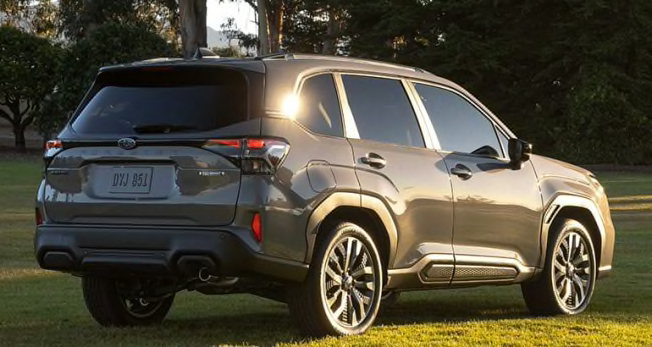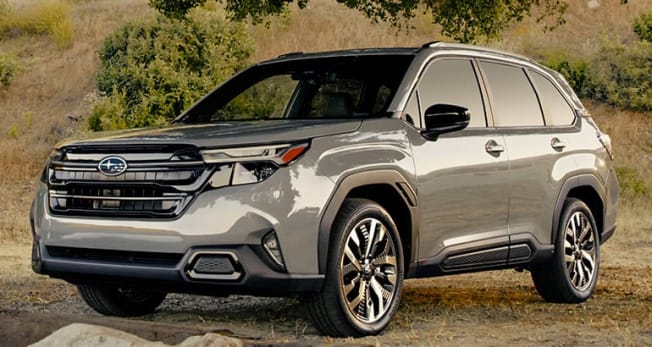Preview: 2025 Subaru Forester Boasts Brawny Styling, More Tech, and a Quiet Cabin
A driver monitoring system and a tablet-style infotainment screen are among upgrades available on top of standard active safety features.

The redesigned sixth-generation Forester continues with its core virtues of great outward visibility, easy functionality, a roomy cabin, and standard all-wheel drive.
The package is wearing a fresh set of clothes, and—not unlike the recent redesigns of the Impreza and Crosstrek—there are a few minor under-the-skin upgrades.

Photo: Subaru Photo: Subaru
CR's Take
The CR Recommended Forester is one of Subaru’s top-selling models, so it’s not surprising that the automaker has made sure the revamped 2025 model still looks familiar as it builds on the strengths that have made it so popular. Improved standard safety features, more available active safety features, a bigger infotainment touchscreen, and even a tiny bit more cargo room are all sure to keep the ball rolling a while longer as American consumers try to squeeze value out of increasingly expensive new cars.
It’s worth noting, though, that if you want many of the most advanced features the new Forester has to offer—driver monitoring and ventilated seats among them—you’ll have to shell out for the top-of-the-line trim, which is likely to carry a significant premium over the base model.
Although past versions of the Forester have scored very well in CR’s road tests, we’ve long taken issue with its relatively noisy cabin, particularly stemming from its flat-four “boxer” engine. Subaru says it has made the cabin significantly quieter, purportedly without making it heavier or less fuel-efficient. That sounds promising, pointing to a great small SUV becoming even better, though more expensive.
Outside
The Forester began life nearly three decades ago as a cute, thrifty little all-wheel-drive utility box, but consumers have since taken to drowning their mounting social and economic sorrows in a sea of ever tougher-looking family haulers. The new Forester does not rank among the most sinister-looking of these, but it certainly looks like it’s been going to the gym for a while.
If anything can be said about the 2025 Forester’s exterior aesthetics, it’s that they skew more brawny than the outgoing model. For starters, there’s the larger grille coupled with smaller LED headlights. The new headlights also move with the steering wheel and include automatic high beams. The tail lamps have also been streamlined and squeezed into a curved strip that slashes across the rear hatch. Larger, almost angular wheel openings and pronounced haunches push the small SUV closer to mainstream American-market design language, in which intimidating, massive-grilled pickup trucks dominate sales and menacing sports cars with angry-frown headlamps set trends.
Do big wheels make a big statement? Possibly, and they’ll cost extra. The lower-end Base and Premium trims come standard with 17-inch wheels, while the midrange Limited trim gets 18-inch wheels. At the upper end of the scale, Sport and Touring trims are fitted with almost-blingy 19-inch wheels. As it has for many years, the Forester has 8.7 inches of ground clearance—more than many other SUVs on the market—to recommend it to buyers who have to deal with heavy snow, or who at least want the capability to drive away from paved surfaces should the need arise.

Photo: Subaru Photo: Subaru
Inside
At first glance, the interior of the 2025 Forester looks largely the same. A keen eye may note that the front seats are a little slimmer, which Subaru says improves visibility between the front and rear rows. And efficiency upgrades have been made to the standard dual-zone climate system.
A few more notable improvements have been made, too. The headliner comes in a dark color now that better hides the inevitable scuffs that result from loading and unloading things through the doors and rear hatch (and for parents, doubtless to obscure the splatter marks from the odd soft-drink eruption). And there’s the claimed quieter cabin, which Subaru attributes to a chassis that’s 10 percent stiffer and uses better welding and more structural adhesive to keep vibration and noise down.

Photo: Subaru Photo: Subaru
For those willing to pay extra, the 2025 Forester can be had with a huge 11.6-inch infotainment touchscreen that comes with a wireless phone charger in the center console and an enhanced service plan that includes GPS-based navigation, enhanced roadside assistance, automatic emergency alert during a crash, vehicle service and health reports, and automatic theft notification and vehicle recovery services. SiriusXM radio and SiriusXM Travel Link—a satellite data service that provides better connectivity to traffic and information updates than phone service can provide—are included in the first four months of ownership for models equipped with the upgraded infotainment system.
There’s also an optional all-weather package that includes heated seats, mirrors, and wipers. The top-of-the-line Touring Trim comes with ventilated front seats—good news for anyone who deals with high temperatures on a regular basis.
Remote keyless entry is now standard across the model lineup, as are Android Auto and Apple CarPlay, and cars not equipped with the top-shelf 11.6-inch tablet-style screen get a pair of 7-inch screens that separate infotainment and connectivity functions from the climate system and other vehicle-specific controls.

Photo: Subaru Photo: Subaru
What Drives It
The 2.5-liter horizontally opposed four-cylinder engine—the “flat four” that has long been a Subaru hallmark—is largely unchanged from the previous model. Horsepower is down two notches, to 180 hp, and torque is up two points, to 176 lb.-ft. A continuously variable transmission (CVT) is the only transmission option. Every trim but the base model gets a manual mode that comes with steering wheel-mounted paddle shifters that allow the driver to “shift” between eight preset ratios for a more sporty driving experience.
The steering system has been upgraded with a power steering rack derived from the sporty WRX parts bin, and all Foresters will come with active torque vectoring—to aid in cornering—and selectable drive modes that allow the driver to choose from settings that range from economical to sporty.
Fuel economy numbers are expected to be similar to the outgoing version, which returned 28 mpg overall in our tests, the best among non-hybrid compact SUVs.

Photo: Subaru Photo: Subaru
Active Safety and Driver Assistance
The EyeSight system is standard across the model lineup and includes automatic emergency braking (AEB) with pedestrian and cyclist detection, and adaptive cruise control (ACC). Subaru says the system has been improved with a wider field of view for better detection, as well as updated control software and an electronic brake booster, for improved response. As a result, the system can now identify pedestrians and cyclists at intersections and apply the brakes if necessary to avoid a strike. Other refreshed Subarus, like the Crosstrek, also benefit from this updated EyeSight system.
The optional blind spot warning (BSW), lane keeping assistance (LKA), and rear cross traffic warning (RCTW) systems include an automatic emergency steering feature that will help the driver avoid an in-lane crash at speeds lower than 50 mph. A 360-degree surround-view camera system is also available and gives the driver a bird’s-eye view of the car on the center screen to help navigate tight spots.
Perhaps the most compelling feature is a driver monitoring system called DriverFocus that uses an interior camera and facial recognition software to watch for driver fatigue and lack of attention. It also allows the driver to use hand gestures to raise and lower the temperature of the climate control system. DriverFocus is standard on the top-of-the-line Touring trim.

Photo: Subaru Photo: Subaru




















